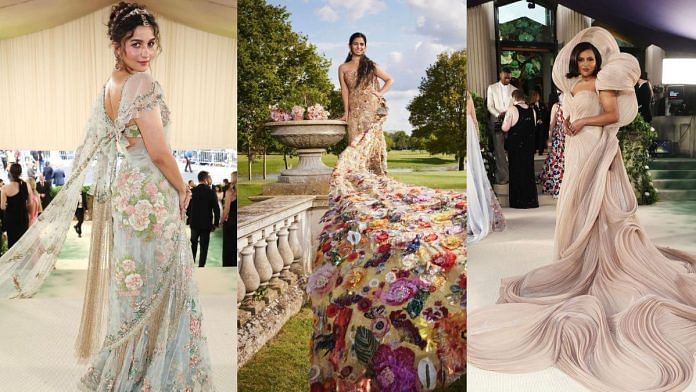The first Monday of May has taken on historic significance—it’s the day of the Met Gala, the annual fundraising event of New York’s Metropolitan Museum of Art’s Costume Institute. It’s the hallmark of cultural capital; a sign of having arrived. So technically, it’s not as much a gigantic surprise as it is an inevitable conclusion, that Indian celebrities are beginning to show up—not in droves.
It’s nudged Cannes aside to become the new aspirational red carpet for Indian and Indian-origin celebrities.
Actors like Alia Bhatt, Deepika Padukone, Priyanka Chopra are now expected as regular fixtures, and by virtue of having enormous wealth, Isha Ambani and Natasha Poonawalla are now seen as paragons of style, so invariably, they make it to the carpet too.
It’s part of the natural scheme of things. Last year Mumbai paid witness to a bordering on obscene display of fashion— the opening night of the NMACC. It very seriously came to be known as India’s Met Gala, with ‘fashion commentators’ and everyone else chomping at the bit at the thought of Zendaya and Gigi Hadid in ‘saris’.
At the NMACC event, Zendaya wore Rahul Mishra, a pioneer of the sari-gown amalgam—which essentially consists of a pallu and a diaphanous train. This year, at the Met, Isha Ambani wore one of Mishra’s creations, which is a sari in name only; marking his label’s debut at what is fashion’s biggest stage. Among other things, Zendaya’s ‘image architect’ and self-confessed brother of Mishra, Law Roach, wore a jacket and trousers by the designer.
Sabyasachi Mukherjee, walking alongside Alia Bhatt, marked another first—he’s the first Indian designer to actually walk the Met carpet. She wore a sari which took an astounding 1,905 hours and the labour of 163 workers to craft. It wasn’t conventional, but international red carpet friendly. However, it did adhere to the more familiar silhouette. It’s not the first time his designs have made it to ‘fashion’s biggest night’. Last year, Poonawalla paired a golden Sabyasachi saree with a Schiaparelli corset.
Mindy Kaling, an Indian diaspora favourite, was in Gaurav Gupta. Designers that one would assume are household names only in India, whose success is governed by patronage they receive from the Indian ecosystem are now finding themselves on ‘global stages’. Whether it’s the cause or the effect—silhouettes and styles are also more nebulous.
There’s no singular culture by which they’re dictated. It’s globalisation at its best or at its worst, depending on which way your personal pendulum swings. It also testifies to the growing credence of our cultural exports, and the fact that it’s only a matter of time before they’re no longer treated as exports, but mutually shared artefacts and enterprises.
Also read: Story of 2023 Met Gala’s Made-in-Kerala ‘red carpet’: 60 days, 40 workers, nearly 7,000 sq m
A gilded cage
This year’s theme is ‘The Garden of Time,’ and is based on a sci-fi short story by British novelist JG Ballard. It represents the symbiotic relationship between literature and fashion, but more importantly, the story is a pretty concrete indictment of the rich. The protagonists spend their lives in blissful nothingness, and they await the coming of an army. They live in a literal gilded cage and wait for it to be usurped.
It’s aristocracy at its insulated peak—and the irony is palpable—given the Met Gala is governed and attended by modern-day aristocracy.
Global representation and the importance of diversity are ideas that are thrown around to the point where they’ve lost all meaning, and while the excitement prevails, it’s worth thinking about the context in which they belong, and whether that yields any value.
Views are personal.
(Edited by Theres Sudeep)






